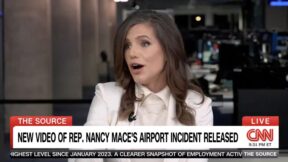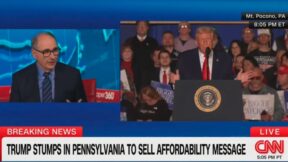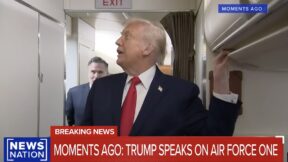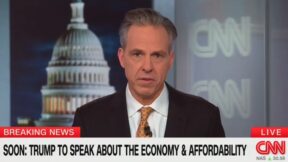The Panic That Wasn’t: Trump’s EU Trade Deal Casts April’s Tariff Freakout in a New Light

(Photo by Samuel Corum/Sipa USA)(Sipa via AP Images)
Back in April, President Donald Trump staged one of his more absurd performances as president — proclaiming “Liberation Day” from international trade abuses and announcing a slew of new tariffs on America’s closest economic partners.
The spectacle was quintessential Trump: theatrical, disorganized, and lacking in policy substance. He lobbed out shock-tariff percentages like a Fox Business fever dream. No one in his administration could explain the details — largely because there weren’t any.
And yet, the media — and much of the political class — sprinted straight into panic mode.
But now, as a formal EU trade deal is reportedly set to be announced — one that includes rollbacks on those very tariffs in exchange for European concessions on U.S. agricultural goods, tech tax moratoriums, and simplified pharma imports — the initial freakout looks a lot less grounded in reality.
It’s stunning to revisit the reaction within hours of Trump’s tarrif announcemnt, cable news chyrons screamed “TRUMP TARIFFS TO EMPTY U.S. SHELVES!” and “ECONOMIC ARMAGEDDON INCOMING.” Paul Krugman called it the “biggest trade shock in history.” Commentators advised Americans to stock up now before Target aisles go dark. It wasn’t just pushback — it was economic apocalypse theater.
The hysteria got fuel from real places: top executives from Walmart, Target, and Home Depot reportedly warned the administration that the policy could cause “inventory collapse” and “holiday chaos.” “If these tariffs go through, Americans will feel it immediately,” said one Walmart exec. “We’re talking about staples — food, home goods, clothing.”
Several high-profile figures took to social media and public forums to sound alarm bells about looming economic catastrophe. Billionaire investor Bill Ackman warned of a “self-induced economic nuclear winter” and likened the policy to a second Great Depression. Sen. Chuck Schumer declared the tariffs could “destroy New York City’s economy” and drive the U.S. into recession. Elon Musk called the plan “super stupid” and explicitly predicted a recession in the second half of 2025. Rep. Jimmy Gomez warned on X that the policy would lead to “empty shelves, higher prices, and fewer choices.” Even conservative economist Thomas Sowell, in a widely circulated interview, cautioned that Trump’s approach echoed the disastrous Smoot-Hawley tariffs that deepened the Great Depression.
The panic hardened into orthodoxy. Trump wasn’t just lobbing bombs — he was detonating the economy. The “Panicans,” as Trump dubbed his chorus of elite critics, had found their Exhibit A.
But then… nothing happened.
The shelves stayed stocked. Prices remained mostly stable (aside from inflation already in motion). There was no collapse, no chaos. And far from triggering a transatlantic recession, EU officials quietly resumed trade talks in June. By late July, a deal was emerging — one that includes tariff rollbacks in exchange for concessions on agriculture, tech taxes, and pharmaceutical imports.
In other words: Trump’s tariff “war” turned out to be less bomb than bluff. A messy bluff, sure — but one that moved the ball.
To be fair, the “Liberation Day” rollout was a mess. Some senior officials were caught off guard, and Trump’s rambling announcement had all the strategic clarity of a YouTube comments section. But the real story wasn’t his incoherence — it was the media’s reflexive overreaction.
Headlines didn’t say “Trump Threatens Tariffs; Experts Warn of Risks.” They said “Retail Price Spikes Imminent” and “Trump Declares Trade War on Europe.” Goldman Sachs projected a one-point hit to GDP. Bloomberg warned of a “global slowdown.” Moody’s said hundreds of thousands of jobs could be lost.
Markets panicked — briefly. The S&P 500 fell nearly 4% over five trading days. Walmart and Target both saw 6% stock dips. But by early May, investor confidence returned. As of July, the S&P 500 has not only recovered — it’s hit record highs, fueled by strong consumer spending and easing trade tensions.
The lesson? This wasn’t sober analysis. It was political forecasting dressed up as economic certainty. And while this phenomenon isn’t uniquely anti-Trump — the early Biden years saw similarly dire (and similarly unfounded) recession predictions — the speed and scale of the freakout in April was its own kind of spectacle.
The real problem wasn’t that journalists and analysts raised concerns. It’s that they treated worst-case scenarios as inevitable. There was no “if these tariffs hold” — only “get ready for collapse.” And they said it even as goods kept moving, ports stayed open, and nothing actually broke.
This column isn’t a defense of Trump’s trade strategy. His approach remains chaotic and often self-defeating. But coverage of his moves has to be more than performative dread. There’s a difference between skepticism and forecasting catastrophe — and too many in the media still don’t know where that line is.
Because when the economy doesn’t crash and the Target aisles stay stocked, people remember. And every false alarm makes it harder to sound the real ones when they do come.
With three and a half more years of Trump in office, there will be more chaos. That’s a given. But maybe — just maybe — the press should wait for the shelves to actually empty before setting theirs on fire.
This is an opinion piece. The views expressed in this article are those of just the author.




